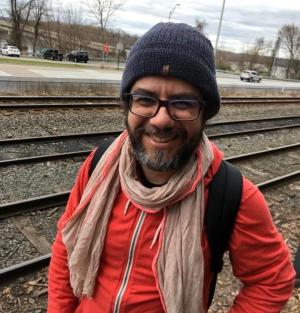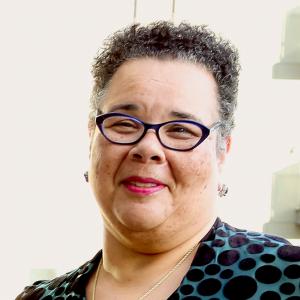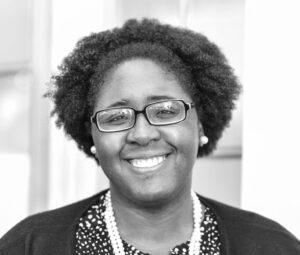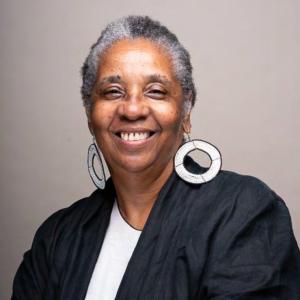Blogs

I have been learning over the last several months that transition is not the same thing as change. Change is something I live with every day as I battle the side effects of diabetes—not ever knowing if my feet will betray me or my hands remain cold all day. Change is a part of my life and living as I see new things from the folks I work with everyday, but then there is a quirk of phrase, the sidelong look, the slight roll of the eye that I had not seen before. Change is something I am trying to make my peace with as I age and get closer to the ages that my parents died, and worry, what this will mean for my spouse and my only sibling, my sister, who is managing mental illness in magnificent ways. Who will be their confidante? Who will be their big sister? As I prepare to leave the deanship at Vanderbilt Divinity School, I am very aware that this transition thing is a whole ‘nother thing altogether. Because it means that I can’t just react to my disease and try to stay on top of it. I can’t just acknowledge that there are some physical acts that I used to do with ease and now, if I can do them at all, they do not come easily or look slightly askew. Transition means that I am leaving something I’ve done and loved but realize that it is time to move on. It is bitter and it is sweet. And there are large parts of the future that I do not know about but have a dim awareness that they are out there. There is only so much I can know about what the full textures of this transition will be. So, I make to-do lists in my head, in print, and then talk about them with the folks in my life and I say over and over again that I am looking forward to what this transition will mean. But I suspect that a part of me is really only doing this as a profound exercise in hope. Because I do like control and order and there is simply the unknown until I walk into this transition each day, hoping that it will be alright and that I do lead well until I no longer carry the marvelous responsibility of my school in ways that only the dean can. And what little I am sure of is that I am looking forward to full-time classroom teaching after a long sabbatical but it will be like learning to ride that bike again. Only this time it’s electric.

Museums were a significant aspect of my childhood education. Living in Philadelphia, we were a family who regularly visited museums and historic sites. Saturday family activities, summertime daytrips, and adventures when out-of-town relatives visited, would typically involve museum excursions. The spring field trips by George Washington Carver Elementary School, funded in-part by monies raised by the parents’ organization, were, joyfully, to the museums. In the 5th and 6th grades, respectively, my parents enrolled me and my brother in Saturday enrichment classes at the Franklin Institute. By high school, we had regularly visited the: Philadelphia Art Museum, Franklin Institute, Please Touch Museum, Pennsylvania Academy of the Fine Arts, Betsy Ross House, Academy of Natural Sciences, Carpenter’s Hall, the African American Museum, and several neighborhood museums. All this is to say, museums were an integral part of how I learned as a child. Then, in college, graduate school, while serving local churches and while on the faculty of a theological school, I only sparingly incorporated museums into my teaching or research. Yes, I planned the occasional field trip, but museums were not vital to my teaching. Museums were not part of my pedagogical repertoire. With delight! - museums have returned to my awareness. I have had the good fortune to visit the National Museum of African American History and Culture, Washington, DC, twice within the past six weeks. These two visits have given me a renewed appreciation for museums and the ways they can and do nurture our curiosity. While visiting the museum, I experienced the power of exhibits to interpret the stories of people. On both visits, we were hosted by Eric Lewis Williams, Ph.D., Curator of Religion at Smithsonian National Museum of African American History & Culture. Dr. Williams curated the exhibit, “Spirit in the Dark: Religion in Black Music, Activism, and Popular Culture.” The exhibit brilliantly and provocatively suggests the myriad of ways in which religion is a part of the cultural fabric of African American experience. As Dr. Williams designed, the viewer’s imagination is captured through photographs, objects, and depictions which makes the exhibit a marvel. With Dr. Williams’ help, I experienced a kind of magic and majesty in the stories told by the artifacts. I viewed, and sometimes handled, objects, relics, remnants, and fragments. Being able to discuss the exhibit, and its design, with the curator - was riveting. The exhibit prompted new perspectives for even the most familiar cultural story. It was fun. It was intriguing. I was wowed and was led to epiphanies! How, rather than planning courses, might we design learning experiences for our adult learners? Since returning to my desk, I have continued to dialogue with Dr. Williams. I am curious about the ways religion and theological classrooms might be strengthened through partnering with museum educators, curators, and administrators. I want to know more about curating, archiving, conservation, and material culture so I can improve my own teaching. I want to better understand collecting, and the ways storytelling through artifacts might be added to adult classrooms. Dr. Williams and I are thinking together about ways the Wabash Center might engage these kinds of questions: What would it mean for the Wabash Center to support faculties to explore ways of incorporating museums into their undergraduate and graduate level curriculum? What could be the role of museums in theological education for the preparation of congregational leadership; for teaching religion in the public; for more interactive educational experiences? In what ways could religion scholars assist museums in their interpretation and presentation of exhibits? What does it mean that, increasingly, critical interpretation of religion and theology is encountered by the public in museums? What if the work of critical interpretation employed in our classrooms is enhanced and enriched through the storytelling approaches of museums? In what ways can we learn to incorporate archiving, curating, conservating and exhibiting into our course design? What can be learned from museum pedagogies to strengthen religious and theological education? Given the prospects of enhancing teaching through museum education practices and visits, and since many professors spend their summers involved in course planning, I encourage you to consider spending part of your summer in museums and historic sites to: get to know museum educators get acquainted with museum curators and administrators enquire about exhibits scheduled for display in the fall and spring semesters plan for certain artifacts to be brought to your classroom during the semester enroll in a workshop offered by the museum learn the ways museums educate the public on your scholarly interests take notice of the many ways that museums make use of digital interaction in order to tell stories rethink and redesign an upcoming course imagine learning activities, student assignments, and excursions that invite students to become curators, archivers, and create exhibits Find the museums on your campus, in your town or city – and have fun!

When utilizing embodied pedagogy, I am constantly aware that my own experience and positionality is limiting. I am a white woman from the southern part of the United States who is currently living in Denver. I have traveled some and have lived in several cities around the United States, but I have never lived abroad. I teach seminar-style classes where dialogue is prioritized and my students speak often. When creating my syllabi, I assign readings that represent a diversity of scholars, and which are mostly academic in focus. But even though I prioritize these things, it is impossible to represent all voices and perspectives in one course. I want to bring in stories and experiences of people from around the world, though, and I want these voices to enter the classroom, to be part of our dialogue. One way that I attempt to do this is to assign novels. Through these readings, fictionalized bodies enter the space of the classroom and allow us to broaden our view of various topics. Last quarter, I taught an introductory level course called World Christianities. One of the course objectives was to outline how Christianity grew from a small group of Jesus followers in a specific region of the world into a global religion with devotees around the world. A second objective was to acknowledge how this transition happened through violence, missionary work, colonialization, enslavement, and various forms of manipulation. To cover a topic like this in a 10-week quarter felt overwhelming at first, and I began to think of authors that I could include who could speak to the distinctiveness of Christianity in a part of the world that is distinct from my own teaching context. The novel I chose was A Grain of Wheat by Ngũgĩ wa Thiong’o. The story is set in Kenya in the 1950s and 60s, during the Mau Mau rebellion and the fight for Kenya’s independence from Britain. The main character, Mugo, spends time in a detention camp run by British colonizers, and he struggles inwardly with his interactions with colonizers, even though his village views him as a hero. Through this fictionalized story that is based on historical events, Ngũgĩ reveals the complexity of his own experiences living in a colonized place like Kenya. As Ngũgĩ discusses in this piece, choosing to write in English, the language of the colonizer, is itself a political decision. Ten years after writing A Grain of Wheat, Ngũgĩ decided to only write in Gikuyu, his mother tongue and the language of his community. I encouraged students to read this novel throughout the course, and we discussed it together during two of the final classes. During one session, we focused solely on the experiences of the characters in this novel. We used the narrative to imagine their experiences and also the ways that Christianity impacted their lives. On the one hand, many characters in A Grain of Wheat were impacted negatively by the impact of Christianity, especially as it was entangled with colonialization. On the other hand, some characters embraced aspects of Christianity and were empowered by certain biblical stories. For example, Kihika (who becomes a martyr after his death) carried a Bible with him and underlined passages of importance to him. After his death, the Bible is passed along to his family and friends who reread the passages he underlined. The text becomes a source of hope to the community. I assign novels in other classes as well. In a course I teach called Women, Gender, and the Bible, I give a list of possible novels that the students can chose from in order to follow their interests. For this class, I include novels such as The Handmaid’s Tale, Parable of the Sower, and The Color Purple. When we discuss the novels, I put the students into discussion groups according to which novel they chose. I then dedicate a class session for the groups to introduce their novel to the rest of the class. The goal of their presentation is to “convince” the other students to read this novel. At the end of the class we have a vote as to which presentation was the most convincing. Similarly, when I taught a course on Jesus in Text and Traditions, I assigned The Book of Longings to provide an imaginative view of the ways in which women could have been involved in Jesus’s life and ministry. Assignments like these have been beneficial additions to my syllabi, and they illustrate my pedagogical goal of creating classroom spaces that include a variety of perspectives as a way of encouraging dialogue. Fictional characters are embodied characters. The experiences they bring into the classroom enhance the content of the class in a number of ways. Returning to the example of Grain of Wheat, the students in World Christianities brought this novel up in their final presentations/projects and also in the course evaluations. They appreciated the inclusion of a story from another part of the world. This one novel provided them with multiple viewpoints of how Christianity impacts a community. In the space of the classroom, these fictionalized bodies came to life and spoke to us about their experiences. In a way, characters like Mugo and the novelist Ngũgĩ joined our classroom and dialogued with us, sharing their experiences and listening to ours.

Scholarship through Performance – Part Two When I started to think about a play, I never imagined how hard it would be. To write/perform a play to bring my clown--a new entity--into existence, is a lot of work. I have a theater director working with me and he tells me to think from my body. We talk so much about bodies but we are so often consumed by our brains and mind. My Brazilian teacher, Luis Louis, tells me repeatedly: “Cláudio, you think too much! Do something first, then you can think.” Oh, this process is literally painful. I asked my teacher to be patient with me as I will struggle through this process of learning. I am learning with my teacher that I have to feel what is within me gaining form and shape, life and spirit! I have my clown living within me, but I must give birth to it! In order to do that I have to play with the movements of the body, with images, and with objects, clothes, hats, etc. And my teacher asks me many questions: How does this clown act alive on stage? Does he speak, and if so, in what language? Does he have repetitive body movements? Does your clown have large or small gestures? What is the heart of the clown composed of and what makes the clown alive? My teacher said: You bringing your clown to life is like your clown throwing a bucket of water into a world on fire, believing that you will be successful. Everybody knows that this is impossible, even ridiculous, but your clown does not know that. He wholeheartedly believes he can do it and will do it, no matter what! That is his gift to the world. The portion below shows my thinking process in engaging different forms of knowing, doing, teaching, and performing. This is how the play started to get a form and shape. Main Theme A clown called Pachamama discovers that the Gaia, the earth, is hurting, and goes around the world feeling its pain and struggling with climate disasters. He then discovers that he is Gaia and a part of it. The show is made of several skits that compose a story and a trajectory (still undefined). Everything is yet to be fully developed and needs to go through the test of practice. In each scene I want the clown moving with death and life, disaster and possibilities, sadness and joy, responding to everything with its usual clumsiness, stupidity, awkwardness, sincerity, naiveté, joy, beauty, etc. With this show, I want to help people find courage to go deep into climate disasters and find agency, hope, and faith in the midst of it all, rather than running away from it. In the end I will honor Prof. James Cone and Union Seminary, who shaped me in so many ways. Major Influences My father, Charles Chaplin, Laurel and Hardy, Emmet Kelly, and Slava’s Snow Show A Metaphor Emmet Kelly carrying a bucket of water in a circus on fire. “Seventy-two years ago today, in Hartford, Connecticut, someone photographed a clown carrying a bucket of water toward a fire. It’s a surreal image, haunting in the old black-and-white way. The clown is stepping through an arid landscape littered with what appear to be wooden crates, a lone railroad car, and the suggestion of bleachers. As clowns go, he’s the sad tramp kind, a pained grimace on his face. In front of him, to the left, someone is exiting the frame—a portion of a leg is visible—and the clown follows, gripping his bucket, exuding dread. He’s heading toward something unseen and tragic, something almost ghostly.” - William Browning This show is precisely this: the show is about a clown carrying a bucket of water to help the earth that is already on fire. Place This is a theater play to be performed at Union Theological Seminary in NYC. The chapel has no fixed seating so I hope to have people sitting on two sides of the chapel (or in a U shape) with the play happening in the middle. The space has some lightning that I can use. Here is a picture of the space. How is this all going to be and happen? I have no idea. One thing, and one thing only, I know: this is much bigger than me. It scares me so much! I hope that with practice anxiety will turn into a certain trust and that as my clown starts to move, I will feel more confident. I will let you know how it goes.


Due to a snow delay, my seven-year-old daughter came with me to class the other day. I teach an honors’ version of our intro Religions of the World course in the morning. She sat at a desk in the back corner of the room, working on a story about, I think, vampires. She nibbled on peanuts. She was the world’s cutest TA. At the end of class, as we were walking back to the car, she said, “Mom, I noticed that the students didn’t laugh at any of your jokes.” A pause. “Was this EMBARRASSING for you??” I laughed and told her, “No, not really, I’m used to it.” I like being a silly willy,” I said, “and it doesn’t really matter to me if they like it.” Most of my students don’t get my sense of humor. They don’t know the references that some of my jokes depend on; I once made mention of the TV show Friends in a class and all I got back were blinking eyeballs. This was not a high point. We don’t share much these days, me and my students. I constantly feel like that Steve Buscemi gif (“How do you do, fellow kids?”). Or maybe my students do get my jokes and they simply don’t think the jokes are all that good. Oh well. ¯_(ツ)_/¯ Silliness can be tricky (and is often presented as inappropriate) in professional contexts. Obviously, people don’t always find the same jokes funny. We may worry about offending. Enough self-deprecating digs and we may start to inadvertently undermine ourselves. There are definitely risks to making light of certain topics—or even being perceived as doing so. (Though some of the sharpest social critiques come in the form of satire, like The Onion simply reposting the same story about gun violence every time a mass shooting occurs in the United States.) But I also sense a resistance to silliness (and playfulness and jokes and levity and all the like) in certain corners of academia, specifically. There seems to be an association between being serious and being taken seriously. That somehow our intellectual cachet or credentials are tied to big words and furrowed brows and the cult of busyness. Certainly we academics have a reputation for humorless stuffiness, paired properly with a tweed jacket and a pocket watch, of course, even if it isn’t true. I do worry sometimes that people think I’m light on substance simply because I’m quick to laugh. Some scholars have written about how incorporating humor into the classroom can have benefits for students and their learning. I would like for this to be true in my classroom too—at the very least, I don’t want my jokes to HARM anyone—but this isn’t mainly why I deploy humor. It’s not some savvy or strategic teaching technique. I do it because this is a part of who I am—an important part of who I am—and I do not want to have to become a different, fragmented, or shell of a person when I teach (or do any other part of my job). I want to be whole—as whole as I can possibly be—when I show up in the classroom. There is enough emotional labor involved in teaching (and I’m using this term in the way Arlie Hochschild actually meant it) to tire even the best of us out. Not being authentic during the hours I teach requires additional levels of effort and exhaustion that I simply do not want to exert, if I can help it. And I want students to witness this wholeness, even if it turns out not to be their cup of tea. (Not unrelated, this is part of the reason I brought my kid to class. I’m a mom…and I refuse to pretend I’m not in order to be “professional.”) My self is not there to please students—or to conform to what (I assume or can discern) they might find pleasing. Who I am is not (or should not be) up for others’ approval or adjudication. Maybe there is a lesson in that for them too. Now, as I’ve written before, there are obviously risks to disclosing who we really are in the classroom, especially depending on the identities some of us hold. (And there are aspects of our whole selves that do not deserve to be shared with people like students who haven’t necessarily earned our trust.) But being silly is an aspect of my personality that feels genuine and low-stakes enough to bring into the classroom space. It feels good to be me, for as many hours of the day as possible. For what it’s worth, my daughter doesn’t think I’m very funny either. She’ll get me some day. Or she won’t. It doesn’t matter. ¯_(ツ)_/¯

Preface It is my pleasure to co-author this blog with Dr. Roger Nam, Professor of Hebrew Bible, Candler School of Theology, Emory University. Dr. Nam and I have been a part of the Wabash Center project for over twenty years. We have had the opportunity to hear, as participants and as participant leaders, the kinds of questions and concerns early career colleagues pose over meals, while canoeing or during the late-night hours in Clifford Lounge. Invariably, issues of thriving, surviving, and knowing “what to do” as an early career person navigating the academy are at the forefront of the concerns and conversations. We understand that questions about the teaching life are just as important as questions about the craft, praxis, and art of teaching. Generative teaching requires a life that is healthy, whole, and resilient – especially in the early stages of any colleague’s career. Roger and I have recorded a series of podcast conversations which engages the questions we heard regularly posed by early career colleagues. These conversations are not meant to give advice to particular situations or specific people, nor are they intended to provide guidance for opportunities. The conversations are intended to suggest the kinds of issues, questions, and curiosities needed to frame moments of discernment, decision making, mentoring, and dreaming. Further, Roger and I are not claiming expertise in any particular situation. Our expertise is in the many conversations we have had with colleagues and the many years we have had as leaders in our own fields of endeavor. Flourishing in the Teaching Life Series Personal Finance and Planning: Roger Nam Healthy and career stability includes planning for the financial future and managing personal funds. Understanding 403B retirement accounts investments, and estate planning is part of faculty wellness. Understanding Institutional Finances: Roger Nam Learning to read institutional budgets, understand endowments, and be knowledgeable about financial reports will assist faculty persons. Being informed about your school’s financial picture is an aspect of personal wellness. Negotiating Job Offers: Roger Nam What is possible as you accept a new job? What kind of agency is needed to feel like you belong at hire? What does it mean to know your worth and value? Charting the Course of a Scholarly Career: Roger Nam Scholarly careers are not linear or tidy. Hear about helpful tools for career management like: creating a map/plan for tenure process and promotion (6 year plan), having more than one mentor, knowing when to leave the first job and when to stay, finding conversation partners for career decisions. Entrepreneurial Ambitions and Insights: Roger Nam What scholarly skills are transferrable to other enterprises? What does it mean to consider an executive position like a deanship or presidency? How do I manage speaking engagements, book deals, and other kinds of opportunities? What is an LLC and do I need one? Negotiating Once you are given a job offer, then it is time to negotiate your needs for hire. Negotiating your contract presumes you have agency concerning your career decision-making and that you have, in depth, researched the institution from which you have received an offer. Negotiating requires that you are not ambivalent about the job. You must have clarity about your needs, the needs of your family and the kinds of provisions you would need to thrive in that specific environment given the geographic location, kind of institution, and your hoped-for career trajectory. Negotiation is context specific – there is no “one size fits” every situation. Be mindful, that while we have heard of each of these items listed below having been negotiated, we have never heard of all these items in any one contract. When negotiating for a job offer, you must consider the context of the school, know your own value to the institution, and consider what you will need to thrive in that location. Your requests should not be capricious and, as in any negotiation, compromise must be part of the engagement. Salary is too often the only consideration of negotiation. Most schools have a determined entry-level salary for early career colleagues and/or the institution has established bans of salaries for the entire institution, which cannot be ignored nor changed. Many starting salaries are not negotiable. That said, even a 1% increase can accrue into a significant amount of money over 10, 20, 30 years of employment. Beyond salary negotiation, it is likely that your ability to thrive depends more on the kinds of items in the list below. Consider negotiating toward these kinds of needed aspects of the job: Title and Status Housing Short term or long term / rent reduction/ mortgage support Equipment (computers, and other technologies) Teaching resources Office location and office furnishings Funds and Funding (access to funds is typically not taxable as they are not part of salary) Moving Funds (Since 2018 moving expenses are not tax deductible except for military members). Often funding amounts are pre-set and moving funds are always considered salary and thus taxable. Consider that if you do not need to move to take the job, ask that these funds be considered a hiring bonus or accessed for some other purpose. Research Funds Travel Funds Student Loan relief Startup costs to help establish a research trajectory (e.g., library funds, index services) Eligibility for tuition remission for children Access to institutional credit card so you do not need to “front” expenses Membership to or use of school’s membership in local institutions (e.g. country club) Classroom resources Scheduling and Timing Course release Course timing and flexibility in mode of teaching Tenure Clock and Sabbatical Clock Committee Relief or Committee Assignment Delay or reduce administrative obligation (e.g., will not chair department until after tenure) Junior faculty sabbatical (leave in preparation for tenure or promotion, year 3, 4, or 5) Staff Support Research Assistant Teaching Assistant Publishing Assistance for: content editing, copying editing, indexing, footnote verification, etc. Access to administrative assistant services Hire of coach for administrative role and responsibilities Grant writing assistant Creation of a center or other institutional project of your own scholarly interest Bottom Line Negotiation depends upon your own agency. Your agency, exercised for your own wellbeing, begins when you submit your job application and continues throughout your career. Too many colleagues accept a job offer without negotiating or without having read the Faculty Handbook, the benefits package, or knowing enough about the culture of the faculty. Learning about the job begins with your preliminary research on the institution before making application, continues with posing your questions at the interviews, includes conversations with knowledgeable mentors and colleagues at other schools. By the time you are offered the position, you should have a clear sense of what is possible for the position you are considering and what you would need from that institution to thrive, flourish, and be well in your work.

PAYING ATTENTION I try to work it in casually, inconspicuously, but of course it is glaring. Students notice it immediately – the emphasis on a student’s progress instead of grades, the focus on their and my mental wellness as the primary means to be sharpest in learning, the inverting of power dynamics and the undoing of traumatizing power relationships in how the classroom is run. My body notices it, too. Decolonizing the classroom is difficult work and wildly unfamiliar territory. It runs directly in the face of what we instructors and professors know the classroom to be. And it runs directly to our worst fears and insecurities and does an elaborate dance around it – but not in a taunting way. It dances freely in a spirit of welcome and joining. A decolonized classroom, this liberating means of being communal learners together, requires constant movement. And truth-telling, where everyone names their fears. Students locate themselves in the learned cycle of education where their performance is assumed to dictate their worth. And instructors and professors work hard to resist the shameful impulse to agree. For this uneven correlation is all we know: performance is worth. Worth is performance. But is worth the performance? Decolonizing work requires an intense amount of internal resistance, of re-narrating what we have been trained to recognize as true, as opposed to what we may instinctually know to be true. Education can be ruthless at worst, engrossed in its unmoving standards at best. Instructors and professors know this all too well: “How else, besides grading, are we supposed to measure progress?” “How else will students take us seriously?” “How do we ensure students prioritize their coursework?” “How do we make sure our assignments do not take a back seat to another’s class or to a student’s ministry or to the ups and downs of their life?” This is the academic-body’s response to fear: rhetorical questions willing to gently carry our insecurity, for we honestly do not know the answer to these questions. And we may never know until we experiment with inverting power in our course structures. And failure. We need to try failure – again and again. And once we are accustomed to failing, to feeling like we are losing our grip on the notion of rigor we were trained to recognize – by sight, or by the all-too-familiar tightness in our chest - we can ask what lesson(s) failure has been trying to teach us all along. We instructors and teachers must become disciples of our failures, insecurities, and fears. Because it almost feels unbearable to not be liked or to feel misunderstood or to sense disrespect. But a decolonial classroom asks the instructor/professor what the lessons are: What messages of community and communal learning are thrust to the fore when the body struggles with varying messages of acceptance? In actively shifting the purview, the how and who, of learning, what might be able to be seen and understood differently? In a world inundated by systems of dominion and domination, mastery and expertise, often ignorant of the fullness or complexity of a person, what might a holistic form of respect look like? It has to be felt in the body. There is no way around it. We will only get pieces, as a common complaint is that we cannot be everything to every student. This much is true; but even in recognizing this expansive truth, expanding our sense of resisting strictures is still a lesson well-learned. HOW TO GAIN TRUST IN THE CLASSROOM Dear instructor/professor, How do you feel? It is only from here, the space of feeling, that decolonial possibility in the classroom can be born. It is not method. It is not strategy or project. It is a return to humanity, it is still-unfolding fullness. The process of learning happens to occur in the midst of a collective space where humans are learning how to be appropriately human together. Your decades of study does matter; but what matters most is your decades of living. Does your living have room in your classroom? This is decoloniality; it is a (means of) living into. To be decolonial means treating people like humans - not objects, or projects, or cogs in a machine - but like their life is beautiful and important and lovely. When instructors/professors begin to get a hold of this – first by addressing our fears, and next by allowing space for our pedagogical dreams to blossom and run a bit freer, then and only then can we broach the conversation and winning students’ trust.

Part Two: Ritual Extends the Depth of Our Imagination. Ritual takes the familiar and enlivens it with our imagination. Consider it this way, you have a favorite dance or song or prayer. The reason we can dance it, sing it, pray it, again and again is that each time our ingenuity takes the work to another dimension. Each time we feel, express, and see something new that we did not experience before. It is this aspect of ritual that makes it meaningful and alive and different from a routine. Each time we engage in ritual it comes alive with the genius of our imagination. Ritual can even begin in our imagination and blossom through its application. We imagine a portal, a doorway in liminal spaces and to our delight, the ritual affords the opportunity to be in liminality and create. So, during the ritual there may be revelation, illumination and even inspiration that touches our spirit so that it becomes real. The ritual has moved from a familiar intent, or action, to the manifestation of our imagining. With practice, we become fluid in ritual making and always expect our imagination to do what it does. In this way, ritual maintains the integrity of being in the present while reaching into the unseen (imagination). Because we are intentional in ritual, it also creates a kind of authority to dreaming and imagining. Ritual helps to declare that what we dream, what we imagine, is as much a part of our collective covenant in Spirit as the faith we have in our Creator and Ancestors working on our behalf. So, do ritual; do ritual to imagine deeply!

“So, if anyone tells you to go to hell,” I say to my students, “you can say, ‘that’s fine—because Jesus has already been there, so I won’t be alone.’” When I started teaching theology at Columbia Seminary nearly twenty years ago, nobody told me that I needed to talk about hell. And for many years I barely mentioned it. In my own formation, from Sunday school through doctoral studies, the threat of hell had been either a quaint theological fragment of an earlier era, or a harmful piece of proclamation from Other Christians. It was not a pressing concern of the contemporary theologians I engaged, and it was not even a major topic for classical theologians like John Calvin. Like James Cone, I was more concerned about living conditions that might be called “hell on earth” than about any future state of punishment. The one place I did address hell was in connection with Jesus’ “descent into hell” (as affirmed in the Apostles’ Creed). Students wondered what in the world this might mean. It regularly prompted discussions between students who were familiar with this line and those whose churches had deleted it. “Do you ‘descend into hell’?” I began to ask my classes early on when we came to the topic. Students tended to have strong opinions. Ruminations on the presence or absence of hell in the creed led me to discover startling good news in this affirmation, in two ways: To say that the human Jesus of Nazareth experienced not only physical death, but the fullness of spiritual alienation from God—and to affirm that this same human is also one with God—is to affirm that God in Jesus somehow enters the depth of human suffering. There is nothing in human experience, not even hell, that is bereft of the presence of God. It’s Romans 8:38-39 all over again. The descent into hell is not the final word. As the ancient image of the “harrowing of hell” and the common Orthodox anastasis icon portrays it, Jesus descends into hell and then draws up those who are dead into new life. Those in Hades are now joined with Christ in resurrection. I would not have reached this recognition of the good news of Jesus’ descent into hell without following the questions of students. But for many years, this is all I said about hell in Theology 1 and 2. That changed recently, as students began to ask new questions. A couple of years ago, toward the end of the second semester of theology, my co-teacher Tim Hartman and I were talking about Christian faith in a world of religious diversity, and several students were troubled. “We have been taught our whole lives that if you do not accept Jesus Christ and confess him as savior, you are going to hell,” they noted. “Why have we not talked about hell all year?” Tim and I paused. When our classroom had been majority white, I had avoided this topic because I did not think it was important—and no one had questioned that choice. Now that our classroom includes a majority of students from communities that have been minoritized because of race or sexuality (or both), the question resounds differently. We decided to make a change. This year, we added some readings about hell in connection with our discussion of salvation. Engaging this conversation directly enabled students to interrogate what they meant by this term, and how it was related to the gospel. Is “salvation” solely an individual matter, as popular visions of hell seem to suggest? Or is it communal, concerned for the well-being of all people and the whole world? Are heaven and hell actual locations, and if so, what does that mean? What does “hell” suggest about the relation of bodies and souls—are we talking about “souls” going somewhere after death? Focusing on hell also enabled us to wrestle afresh with Calvin’s doctrine of double predestination, in which eternal damnation is not the main point, but is a logical consequence of God’s eternal decree. Not many people (including me) wanted to defend Calvin on this point, but how does hell acknowledge the reality of God’s righteousness, and the significance of human responsibility? And finally, how has teaching about hell functioned in our churches, particularly in ways that harm people who do not conform to social norms? When we followed our students’ questions and made room for conversation about hell, it defused the concerns about its absence. Hell, actually became a fruitful part of a larger whole. So, here’s the takeaway: Following the surprising questions of students, even into hell, led to my own deeper discovery of the good news of a topic that I had previously avoided. How might attention to other student questions similarly open new vistas of discovery in the theology classroom?
Categories
Write for us
We invite friends and colleagues of the Wabash Center from across North America to contribute periodic blog posts for one of our several blog series.
Contact:
Donald Quist
quistd@wabash.edu
Educational Design Manager, Wabash Center
Most Popular

Co-Creating an Online Education Plan
Posted by Samira Mehta on June 10, 2024

Cultivating Your Sound in a Time of Despair
Posted by Willie James Jennings on June 4, 2025

Are You Okay?
Posted by Nancy Lynne Westfield, Ph.D. on October 1, 2025

Judged by Your Behavior: Talk is Cheap
Posted by Nancy Lynne Westfield, Ph.D. on June 1, 2024

Plagiarism as Gaslighting in the Time of Artificial Intelligence
Posted by Brian Hillman on September 8, 2025